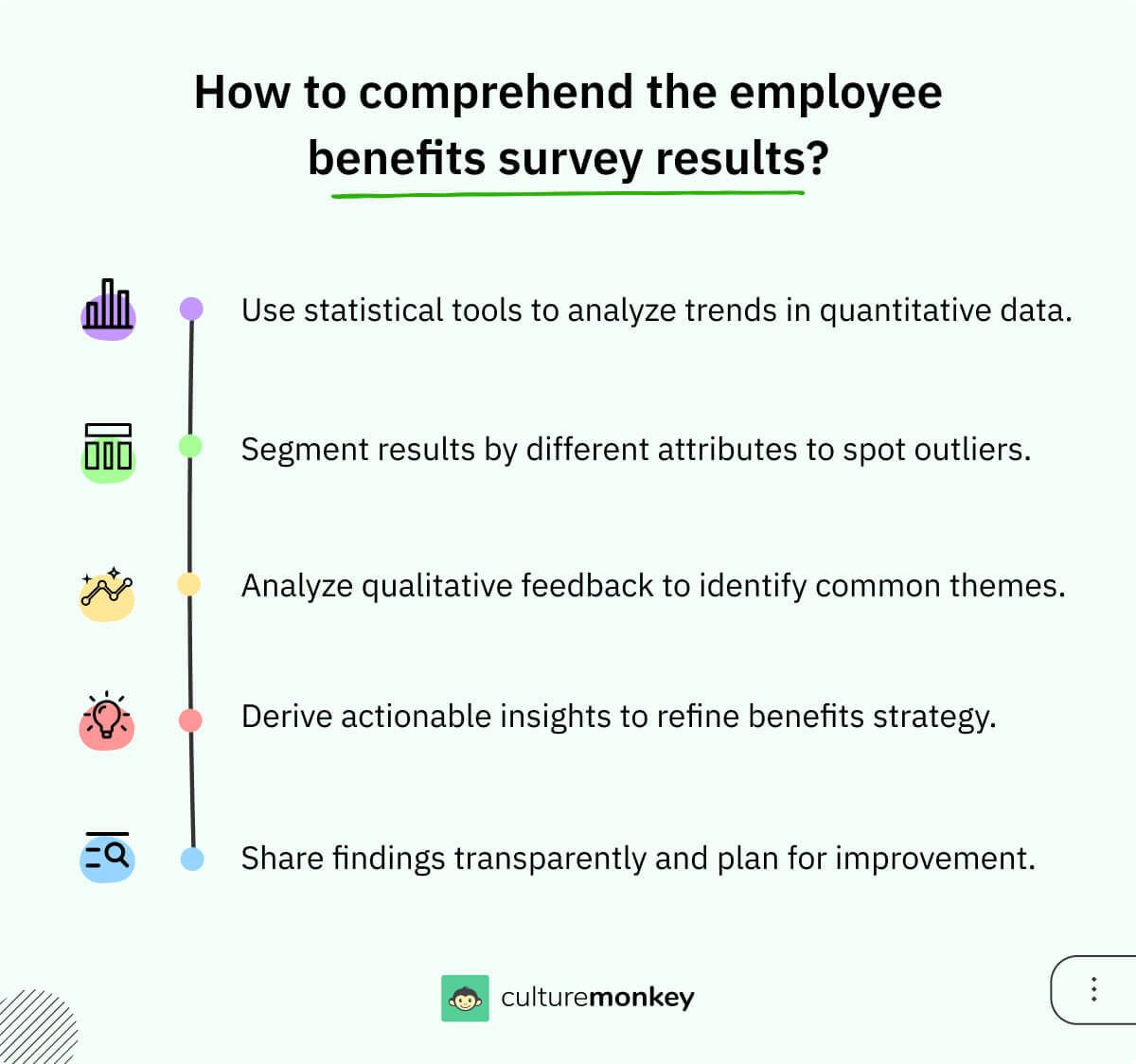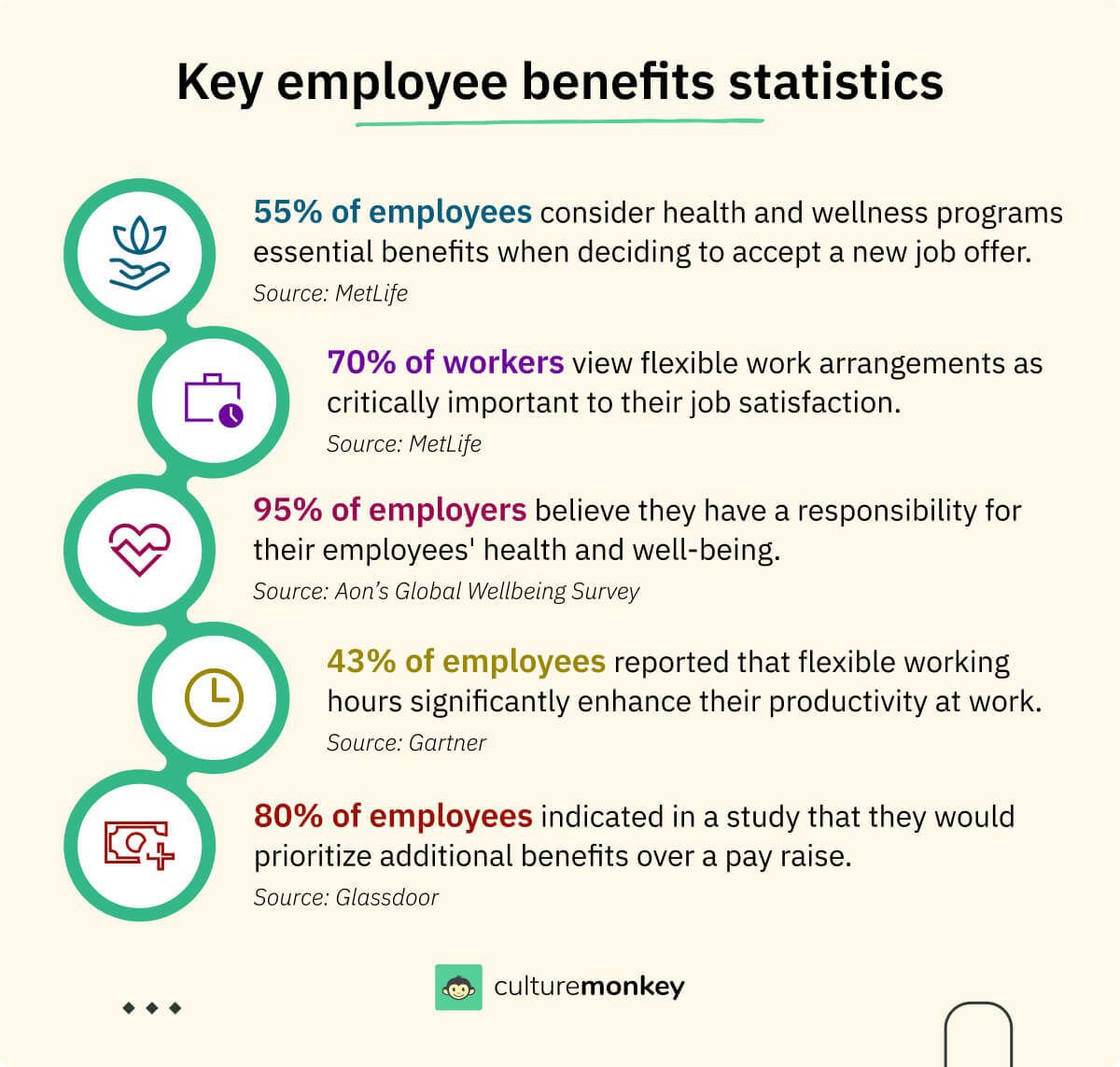Top 85+ employee benefits survey questions to ask in 2024

In the fast-paced world of 2024, where workplace dynamics resemble a high-speed rollercoaster, the importance of understanding your employees' needs has never been more critical.
Just like your favorite streaming service customizes recommendations to your binge-watching habits, tailoring benefits to your employees' preferences is the key to a satisfied and engaged workforce.
It's no longer a one-size-fits-all game; it's about curating the perfect benefits playlist. And to do that, you need the ultimate toolkit: employee benefits surveys.
In this blog, we're diving headfirst into the cosmos of 85+ insightful, and downright genius employee survey questions that will help you decide what your employees truly desire from their benefits package in this brave new world of 2024.
Blog Highlights


What are employee benefits?

Employee benefits, often referred to as perks or fringe benefits, are non-salary compensations that employers offer to their employees in addition to their regular wages or salaries. These benefits are designed to enhance the overall compensation package, improve the quality of work-life, and attract and retain talent.
Employee benefits can vary widely from one organization to another, but they commonly include:
- Healthcare benefits: These encompass medical, dental, and vision insurance plans, allowing employees access to medical services, preventive care, and treatments.
- Retirement benefits: Such as 401(k) or pension plans, which help employees save for their future and provide financial security in retirement.
- Paid time off (PTO): Including vacation days, sick leave, and holidays, allowing employees to take time off with pay.
- Flexible work arrangements: Remote work options, flextime, or compressed workweeks, providing employees with a work-life balance.
- Wellness programs: Promoting employee health through gym memberships, wellness challenges, or access to fitness facilities.
- Education benefits: Employers offer tuition reimbursement, access to professional development, or continuing education to support career growth and skill enhancement.
- Transportation benefits: Commuting subsidies, public transit passes, and carpool incentives help reduce employee travel costs and improve convenience.
- Childcare benefits: These include on-site childcare, subsidies, or partnerships with childcare providers, helping employees balance work responsibilities with family needs.
- Parental leave benefits: These offer paid time off for maternity, paternity, or adoption, supporting employees in managing family obligations and promoting a family-friendly workplace culture.
Employee benefits are a crucial component of the total compensation package, influencing job satisfaction, morale, and overall well-being. They also play a significant role in attracting top talent and retaining valuable employees in a competitive job market.
The specific benefits offered can vary based on an organization's size, industry, and location, as well as its commitment to supporting its employees' needs and aspirations.
Why are employee benefits so important?

Employee benefits are a strategic investment that goes beyond compensation. They contribute to a positive workplace culture, employee well-being, and the overall success of the organization.
Here are some crucial reasons to consider -
- Attraction and retention: Competitive benefit packages attract top talent and retain experienced employees. In a tight job market, benefits can be a differentiator for potential hires and a reason for current employees to stay.
- Motivation and job satisfaction: Benefits like healthcare, retirement plans, and paid time off enhance job satisfaction and motivation. When employees feel their well-being is valued, they tend to be more engaged and productive.
- Health and wellness: Healthcare benefits support employees' physical and mental well-being. Regular check-ups, preventive care, and access to healthcare resources can improve overall health and reduce absenteeism.
- Financial security: Retirement plans, stock options, and life insurance provide financial security for employees and their families, reducing stress and promoting financial wellness.
- Work-life balance: Benefits like flexible work arrangements, parental leave, and wellness programs promote work-life balance. This, in turn, reduces burnout and increases overall happiness.
- Tax advantages: Many employee benefits offer tax advantages for both employers and employees. Contributions to retirement plans, for example, are often tax-deductible.
- Competitive edge: Offering comprehensive benefits can give companies a competitive edge in recruiting and retaining talent. It can also enhance their reputation as an employer of choice.
- Legal and regulatory compliance: Compliance with labor laws and regulations, such as the Affordable Care Act in the United States, is often tied to providing certain employee benefits. Failure to comply can result in legal issues and penalties.
- Productivity and engagement: When employees are healthy, motivated, and secure, they are more likely to be productive and engaged in their work.
- Cost savings: While providing benefits involves costs, they can lead to cost savings in the long run. Healthy employees are less likely to require expensive medical treatment, and engaged employees are more efficient and less prone to turnover.
What is the workplace benefits survey?

A workplace benefits survey is a strategic tool employed by organizations to systematically gather employee feedback regarding their satisfaction and preferences concerning the various benefits provided by the company.
This survey plays a pivotal role in assessing the overall well-being of the workforce and aids in shaping comprehensive benefits packages tailored to meet the diverse needs of employees.
The primary purpose of a workplace benefits survey is to evaluate employee satisfaction with existing benefits, encompassing healthcare, retirement plans, paid time off, flexible work arrangements, professional development opportunities, financial wellness programs, childcare benefits, transportation benefits, and other relevant perks.
The survey seeks to identify areas of improvement or modification within these benefits, enabling organizations to align their offerings with the evolving expectations and requirements of their workforce.
Furthermore, a workplace benefits survey serves as a crucial instrument for organizations to gauge the effectiveness of their current benefits strategies in attracting and retaining top talent.
By understanding the preferences and priorities of employees, companies can refine their benefits packages to not only meet legal compliance and industry standards but also to gain a competitive edge in the recruitment landscape.
What is the purpose of the employee benefit survey?

The purpose of an employee benefits survey is multifaceted and serves various critical objectives within an organization:
Assess employee satisfaction
Employee benefit surveys gauge how satisfied employees are with their current benefits packages. This feedback helps employers understand which benefits are valued and which may need improvement or modification.
Identify needs and preferences
Surveys help organizations identify the specific needs and preferences of their diverse workforce. Different employees may prioritize different benefits, and these surveys allow for tailoring benefits to match employee demographics and preferences.
Retention and attraction
By understanding what benefits matter most to employees, organizations can tailor their benefits packages to attract top talent and retain valuable employees. This can be a significant competitive advantage in recruitment.
Cost management
Surveys help companies manage benefit costs efficiently. They provide insights into which benefits employees value most, allowing employers to allocate resources effectively and maximize the return on investment in employee benefits.
Engagement and productivity
Engaged employees are often more productive. Benefit surveys can uncover how benefits impact engagement, helping organizations fine-tune their packages to boost overall employee morale, commitment, and productivity.
Legal compliance
Benefit surveys assist in ensuring legal compliance. Employers must provide certain benefits as mandated by local labor laws, and surveys help confirm that these obligations are met.
Communication and transparency
Surveys offer a platform for open and transparent communication between employers and employees. Sharing survey results and explaining decisions made based on feedback fosters trust and collaboration.
Benchmarking
Comparing benefit offerings and employee satisfaction levels with industry benchmarks helps organizations remain competitive. It allows them to keep up with evolving industry standards.
Enhancing employee well-being
Employee benefit surveys contribute to enhancing overall employee well-being by identifying gaps or areas where additional support may be required.
This holistic approach enables organizations to create a work environment that not only meets the professional needs of employees but also supports their overall health and well-being.
Customization for diverse demographics
Benefit surveys assist in recognizing the diverse demographic composition of the workforce. This information enables employers to customize benefits to meet the unique needs of different employee groups, ensuring inclusivity and equity in benefit offerings.
Strategic decision-making
Through the insights gained from benefit surveys, organizations can make strategic decisions regarding their overall employee compensation and benefits strategy.
This data-driven approach helps in aligning benefits with the company's long-term goals and objectives, fostering a more sustainable and forward-looking approach to employee satisfaction and well-being.
Employee benefit surveys serve as a vital tool for organizations to understand, adapt, and optimize their benefits packages. They contribute to employee satisfaction, talent attraction, cost management, and overall business success by ensuring that benefits align with employee needs and organizational goals.
The evolution of employee benefits and their impact on retention
The evolution of employee benefits programs has had a profound impact on workforce retention, influenced by historical shifts and societal changes over time.
The roots trace back to the 19th century when industrialization reshaped labor practices. In the United States, the early adoption of employee benefits was seen as employers sought to attract and retain skilled workers amidst industrialization.
Notably, the German Empire under Otto von Bismarck introduced social insurance programs in the 1880s, laying the groundwork for modern benefits like health and accident insurance. During the early 20th century, employee benefits continued to expand. The introduction of the U.S. Social Security Act in 1935 was a critical milestone, offering retirement security and creating a model for federal benefits.
World War II accelerated the evolution, as wage freezes led companies to attract talent through benefits such as health insurance and pensions, shifting the landscape toward fringe benefits. The UK's National Health Service, established post-war in 1948, further underscored the role of healthcare in retaining talent.
The mid to late 20th century witnessed a surge in employee benefits programs, including healthcare, pensions, and paid leave, driven by economic prosperity and legal mandates. ERISA's introduction in 1974 set standards for pension and health plans, enhancing employee security.
The rise of flexible work arrangements and non-traditional benefits in the late 20th and early 21st centuries, spurred by technological changes and workforce demands, reflects how retention strategies have evolved.Today, benefits go beyond traditional packages, emphasizing healthcare coverage, flexible work, and well-being initiatives.
This evolution demonstrates how robust benefits systems are key to reducing turnover, improving company culture and increasing engagement, adapting to societal needs, and maintaining competitive edge in attracting talent.
How to craft your employee benefits survey template?

Creating a well-crafted employee benefits survey template is essential to gather valuable insights and feedback from your workforce effectively. Here's a step-by-step guide:
1. Define survey objectives:
Clearly outline the goals and objectives of your survey. What specific information are you seeking? Is it to assess satisfaction, identify areas of improvement, or gather demographic data?
2. Select the right survey tool:
Choose an online survey platform or software that suits your organization's needs. Ensure it offers features like customization, anonymity, and data analysis capabilities.
3. Determine survey length:
Keep the survey concise to maximize participation. Ideally, it should take employees no more than 10-15 minutes to complete.
4. Design a clear introduction:
Start with an engaging and informative introduction. Explain the purpose of the survey, how the data will be used, and assure respondents of anonymity.
5. Use a mix of question types:
Employ a variety of question types, including multiple-choice, Likert scale, open-ended, and ranking questions. This provides a comprehensive view of employee opinions.
6. Focus on specific benefits:
Divide the survey into sections, each focusing on different benefit categories such as healthcare, retirement, wellness, or professional development. This structure ensures a systematic approach.
7. Ask about importance and satisfaction:
For each benefit category, inquire about the importance of the benefit to the employee and their satisfaction level. This helps identify areas that may need improvement.
8. Include open-ended questions:
Include open-ended questions that encourage employees to provide detailed feedback, suggestions, and specific examples related to their benefit experiences.
9. Consider demographic questions:
Incorporate demographic questions, such as age, tenure, or department, to segment and analyze responses based on employee characteristics.
10. Ensure clarity and avoid bias:
Phrase questions clearly, avoiding jargon or biased language. Ensure that questions are easy to understand, and response options cover the entire spectrum of opinions.
11. Pilot test the survey:
Before distributing the survey, pilot-test it with a small group of employees to identify any issues with clarity or functionality.
12. Set a deadline:
Establish a deadline for survey completion to create a sense of urgency and ensure timely responses.
13. Communicate and distribute:
Communicate the survey's purpose and importance to employees. Clearly explain how to access and complete the survey, whether through email, a web link, or the company's intranet.
14. Analyze and act:
Once you've collected responses, analyze the data to identify trends, areas for improvement, and strengths in your benefits program. Use the insights to inform your benefits strategy and make necessary changes.
15. Provide feedback:
After analyzing the data, share the survey results and the actions you plan to take based on the feedback with employees. Transparency enhances trust and demonstrates your commitment to their well-being.
By following these steps and tailoring your employee benefits satisfaction survey template to your organization's unique needs, you can effectively gather valuable insights to optimize your benefits program and enhance employee satisfaction.
Employee benefits survey guidelines you should be aware of

Adhering to employee benefits survey guidelines helps ensure that your employee benefits survey is well-structured, unbiased, and capable of providing valuable insights that can drive positive changes in your organization's benefits program and employee satisfaction levels.
Here are some essential guidelines to keep in mind when conducting an employee benefits survey:
- Clearly define objectives: Begin by clearly outlining the purpose and objectives of the survey. Know what specific information you want to gather and why.
- Ensure anonymity: Assure employees that their responses will remain anonymous. This encourages honest feedback without fear of repercussions.
- Use a diverse question set: Include a mix of question types, such as multiple-choice, Likert scale, and open-ended questions, to gather comprehensive insights.
- Segment responses: Collect demographic information (e.g., age, department, tenure) to segment and analyze responses by employee groups.
- Keep it concise: Design a survey that can be completed in a reasonable time frame (ideally 10-15 minutes) to maximize participation.
- Avoid leading questions: Phrase questions neutrally to prevent bias that may influence responses.
- Test for clarity: Pilot-test the survey with a small group to ensure questions are clear and understandable.
- Provide context: Offer context for questions, especially when inquiring about benefits or policies that employees might not be familiar with.
- Include an open-ended section: Allow employees to provide additional comments, suggestions, or examples to provide qualitative insights.
- Communicate results and actions: After analyzing the data, share the survey results with employees and outline the actions the organization plans to take based on the feedback. This demonstrates transparency and commitment to improvement.
- Follow-up: Conduct regular follow-up surveys to track changes in employee satisfaction and the effectiveness of implemented actions.
- Benchmark against industry: Compare your survey results to industry benchmarks to gain insights into your organization's competitive positioning.
- Incorporate feedback: Actively use survey feedback to make informed decisions about benefits offerings and communicate these changes to employees.
- Respect privacy: Handle survey data with care, adhering to data privacy regulations and ensuring the security of respondents' personal information.
- Encourage participation: Promote survey participation through multiple communication channels, including email, intranet, and in-person announcements.
How do you conduct a benefit survey?
To conduct a benefit survey, begin by defining clear objectives for the survey and ensuring respondent anonymity. Develop a well-structured questionnaire with a mix of question types, including multiple-choice, Likert scale, and open-ended questions, covering various benefit categories.
Segment responses by demographics such as age, department, or tenure. Keep the survey concise, aiming for a completion time of 10-15 minutes. Pilot test the survey for clarity and accuracy. Communicate the survey's purpose and instructions to employees, and provide a deadline for completion.
Analyze the collected data, identify trends and areas for improvement, and share the results and planned actions with employees. Follow up with regular surveys to track changes and continually improve your benefits program.
How do you survey employees about benefits?

Surveying employees about benefits is a crucial process that demands thoughtful planning and execution. Effectively gathering insights from the workforce ensures that organizations can tailor their benefits packages to meet the diverse needs and preferences of employees.
Employers can employ several strategic approaches to conduct meaningful and informative employee benefits surveys.
Design a comprehensive survey instrument:
- Develop a well-structured questionnaire that covers all aspects of employee benefits, including healthcare, retirement plans, paid time off, flexible work arrangements, and other relevant perks.
- Ensure that the survey incorporates a mix of closed-ended and open-ended questions to obtain quantitative data as well as qualitative insights.
Communicate the purpose clearly:
- Clearly communicate the objectives of the survey to employees. Explain that their feedback is integral to enhancing the overall benefits program and creating a more supportive work environment.
Ensure anonymity and confidentiality:
- Assure employees that their responses will remain confidential and anonymous. This fosters an environment where employees feel comfortable providing honest feedback, leading to more accurate insights.
Choose the right survey platform:
- Select a user-friendly and efficient employee engagement survey platform that facilitates easy distribution, completion, and analysis of the survey. Many organizations use online survey tools that provide features like real-time analytics and customizable survey designs.
Establish a survey timeline:
- Set a clear timeline for the survey, including deadlines for completion. This helps in managing expectations and ensures a timely collection of data.
Utilize multiple communication channels:
- Employ a variety of communication channels to reach all employees, including email, intranet announcements, and company-wide meetings. This ensures that the survey reaches a broad audience, including those who may not regularly access certain communication channels.
Incorporate benchmarking questions:
- Include benchmarking questions to assess how your company benefits compare with industry standards. This provides valuable context for understanding the competitiveness of your benefits offerings.
Encourage honest feedback:
- Encourage employees to provide candid feedback. Assure them that constructive criticism is welcomed, as it contributes to the continuous improvement of the benefits program.
Conduct follow-up sessions:
- Consider hosting follow-up sessions or town hall meetings to discuss the survey results and proposed changes. This enhances transparency and allows employees to understand how their feedback has influenced decision-making.
Implement changes based on feedback:
- Act on the insights gathered from the survey. Implement changes and improvements based on the feedback received, demonstrating a commitment to addressing employee concerns and enhancing the overall benefits experience.
Common example employee benefits survey question formats
To effectively gauge employee preferences, satisfaction, and overall sentiment about benefits, organizations often employ tailored employee benefits surveys . Different rating scales provide deeper insights, enabling employers to fine-tune their offerings and better meet employee needs. Here are six common example question formats that you incorporate in your own survey:
- Importance scale: How important is having flexible working arrangements to you?
Rating scale: Very important, Important, Neutral, Less important, Not important at all - Agreement scale (Likert): I feel that my current paid leave benefits meet my personal needs and expectations.
Rating scale: Strongly agree, Agree, Neutral, Disagree, Strongly disagree - Satisfaction scale: How satisfied are you with the retirement benefits provided by our company?
Rating scale: Very satisfied, Satisfied, Neutral, Dissatisfied, Very dissatisfied - Frequency scale: How often do you utilize the professional development opportunities provided by the organization?
Rating scale: Frequently, Occasionally, Rarely, Never - Agreement scale (Likert): I believe the company's benefits program meets my personal and professional priorities, such as healthcare coverage, flexible work hours, and paid leave.
Rating scale: Strongly agree, Agree, Neutral, Disagree, Strongly disagree
85+ Employee benefits survey questions to ask your employees

Employee benefits survey questions can serve as a comprehensive starting point for gathering feedback from employees about their benefits preferences and experiences.
Here are 85+ employee benefits survey questions categorized by different aspects of the employee benefits plan:
Click to copy survey questions content_copy
Healthcare benefits:
- How satisfied are you with our current health insurance coverage?
- Have you experienced any challenges in accessing healthcare services through our plan?
- Are there specific health services or treatments you believe should be covered that currently aren't?
- How important is dental coverage to you, and how satisfied are you with our dental benefits?
- Do you feel that our mental health coverage adequately meets your needs?
- Do you feel the current health insurance provided offers sufficient coverage for preventative care services?
- Are there any additional health and wellness benefits you would like to see included in our plan?
- How would you rate the ease of understanding and using our health insurance benefits?
Retirement benefits:
- Are you aware of our retirement savings plan (e.g., 401(k))?
- How satisfied are you with the company's contribution to your retirement plan?
- Are you comfortable with your current retirement savings strategy?
- Would you appreciate more financial planning resources for retirement?
- What age do you plan to retire, and do you feel our plan aligns with your retirement goals?
- How confident are you that the current retirement plan will meet your future financial needs?
- Would you find value in personalized consultations about retirement planning?
- Are there specific investment options you wish were included in the retirement savings plan?
Paid time off (PTO):
- Are you satisfied with the amount of paid time off (e.g., vacation, sick leave) provided?
- Have you faced any challenges in taking PTO, such as approval or workload issues?
- Are there specific holidays or additional PTO days you would like to see added?
- How often do you take advantage of our PTO benefits?
- Would you prefer more flexibility in how you use your PTO?
- Do you feel the current PTO policy supports a healthy work-life balance?
- Are there any improvements you’d suggest for the process of requesting and approving PTO?
- How satisfied are you with the communication regarding unused PTO or rollover options?
Flexible work arrangements:
- Have you utilized flexible work options (e.g., remote work, flexible hours)?
- Do you believe these options improve your work-life balance?
- Are there any challenges you face when working remotely or adjusting your work hours?
- How would you rate the effectiveness of our flexible work policies?
- Are there any additional flexible work arrangements you'd like to see implemented?
- How satisfied are you with the technology and tools provided to support flexible work arrangements?
- Do you feel that flexible work options are applied consistently across teams and departments?
- How effective is communication with your team and manager while working under a flexible arrangement?
Professional development:
- Are you aware of the professional development opportunities offered by the company?
- Have you participated in any training or development programs?
- Do you feel supported in pursuing further education or certifications?
- Would you like more personalized career development guidance?
- How important is ongoing training and skill development to you?
- How effective are the current professional development programs in helping you achieve your career goals?
- Would you find value in mentorship opportunities within the organization?
- Are there sufficient opportunities for cross-departmental learning or skill-building initiatives?
Financial wellness:
- Are you aware of our financial wellness programs or resources?
- Have you utilized financial planning services offered by the company?
- Do you feel financially secure in your current role?
- Would you appreciate more financial wellness workshops or resources?
- How well do you think our financial benefits align with your financial goals?
- How effective are the current financial wellness programs in helping you plan for long-term financial stability?
- Would you find value in one-on-one financial counseling sessions provided by the company?
- Are there any specific financial topics or resources you feel should be included in future wellness benefits packages?
Childcare benefits:
- Are you aware of our childcare benefits or services?
- Have you used any of these benefits (e.g., on-site childcare, subsidies)?
- Are there any challenges you face related to childcare while working?
- How satisfied are you with the current childcare benefits?
- Do you believe we should expand or modify our childcare offerings?
- How well do the current childcare benefits package meet your family’s needs?
- Would you benefit from additional childcare support, such as emergency care options or flexible childcare hours?
- Are there specific childcare services or programs you wish were included in the company’s offerings?
Transportation benefits:
- Are you aware of the transportation benefits provided by the company?
- Do you utilize transportation benefits like transit passes or parking allowances, and how satisfied are you with them?
Mentorship programs:
- Are you familiar with the company's mentorship programs?
- Have you been involved as a mentor or mentee, and what was your experience?
- Do you believe mentorship contributes to your professional growth and job satisfaction?
- Would you like to see any changes or improvements to our mentorship programs?
- How does the availability of mentorship opportunities impact your commitment to personal and career development?
- How satisfied are you with the accessibility of mentorship opportunities within the organization?
- Would you find value in structured mentorship programs tailored to specific career paths or goals?
- Are there any additional resources or support you believe could enhance the mentorship experience?
Vision benefits:
- Are you satisfied with the vision coverage provided by the company?
- Have you faced any difficulties in accessing vision care services through our plan?
- Are there specific vision services or treatments you think should be included in our benefits?
- How important is vision coverage to you, and how satisfied are you with our current offerings?
- Do you believe our vision health benefits align with your eye care needs?
- How well does the current vision plan support routine eye care needs, such as exams and glasses?
- Are you satisfied with the network of providers available under the vision coverage?
- Would you find value in additional vision benefits, such as discounts on laser eye surgery or specialized treatments?
Technology benefits :
- How satisfied are you with the company-provided tools and software for completing your work efficiently?
- Do you feel that the organization provides adequate training on using new technologies effectively?
- How often do technology-related issues, such as slow systems or outdated software, impact your productivity?
- Are there specific technological tools or resources you feel could improve your workflow or efficiency?
- Do you think the organization prioritizes providing ergonomic and user-friendly equipment, such as monitors, keyboards, and chairs?
- How satisfied are you with the IT support services available for resolving technical issues?
- Would you benefit from wellness initiatives that address digital fatigue, such as screen breaks or technology-free zones?
- Do you feel the current technology infrastructure supports seamless collaboration in a hybrid or remote work environment?
Wellness benefits :
- How satisfied are you with the company’s wellness programs like fitness memberships ?
- Do you feel the current benefits program offered effectively addresses your physical and mental health needs?
- Are there additional wellness programs and initiatives, such as mindfulness workshops or stress management sessions, that you would find valuable?
- How often do you participate in wellness activities provided by the company?
- Do you believe the current wellness benefits contribute positively to your overall work-life balance?
- Are there any barriers preventing you from utilizing the wellness programs offered by the organization?
- How satisfied are you with the accessibility of wellness resources, such as virtual fitness sessions or counseling services?
- Would you benefit from expanded wellness offerings like holistic health initiatives?
The four benefits that employees are willing to switch jobs for

In a competitive job market, employees often weigh their options and evaluate potential job changes based on the benefits provided by employers. According to an Economist Impact study, 70% of U.S. workers are willing to switch jobs for better benefits, emphasizing the critical role that comprehensive benefit offerings play in career decisions.
The modern workforce values benefits that enhance their quality of life, overall well-being, and work-life balance. Here are the four key benefits employees are willing to switch jobs for:
Comprehensive healthcare and medical insurance:
Access to robust healthcare and medical insurance remains a top priority for employees. Beyond standard coverage, individuals seek comprehensive plans covering mental health, dental, vision, and even wellness program like gym memberships or nutrition counseling.
Employers offering lower out-of-pocket costs, flexible network options, and mental health benefits are more attractive to top talent. The rising costs of healthcare make strong health benefits crucial in career decisions. Employees desire peace of mind, knowing they and their families are protected against unexpected medical expenses.
Flexible working arrangements
The modern workforce places significant value on flexibility, with 40% of global employees identifying workplace flexibility as one of the top three benefits they consider when exploring new job opportunities.
Remote work, hybrid setups, and flexible hours allow employees to better manage personal obligations, reduce commuting stress, and create customized work environments. Employers embracing flexibility demonstrate trust and respect, fostering increased job satisfaction, loyalty, and engagement among their workforce.



In order to build a rewarding employee experience, you need to understand what matters most to your people.
Advisor and Mentor
Aragon Launchpad Academy
Generous leave benefits
Time away from work is vital for employee well-being and productivity. Comprehensive leave policies go beyond standard vacation and sick days to include offerings such as parental leave, bereavement leave, mental health days, and even sabbaticals.
For Gen Z workers, paid leave ranks as their top priority among benefits—surpassing even health insurance—with 69% describing it as a "must-have," according to 2024 MetLife data. Employers that prioritize leave benefits demonstrate a commitment to their employees’ holistic needs, contributing to reduced burnout, improved mental health, and a greater sense of being valued.
Career development opportunities
Professional growth remains a key motivator for employees seeking meaningful work. The 2024 SHRM Employee Benefits Survey highlights that 64% of employees prioritize career development opportunities.
Employers investing in skill development, offering mentorship, supporting career advancement, and providing access to workshops signal their commitment to employee growth. Such investment fosters loyalty, engagement, and a sense of purpose, driving both individual and organizational success.
Employee benefits questionnaire: Sample questionnaire on compensation and benefits
An employee benefits survey serves as a critical tool for organizations to evaluate and improve their compensation and benefits packages. Here is a sample employee benefits survey template covering key aspects of compensation and benefits .
- How satisfied are you with your overall compensation package (salary, bonuses, etc.)?
Very satisfied, Satisfied, Neutral, Dissatisfied, Very dissatisfied - How important is health insurance coverage to your overall job satisfaction?
Very important, Important, Neutral, Less important, Not important at all - How likely are you to recommend the company's compensation and benefits program to a colleague?
Highly likely, Likely, Neutral, Unlikely, Highly unlikely - How satisfied are you with the flexibility of your paid leave options?
Very satisfied, Satisfied, Neutral, Dissatisfied, Very dissatisfied - To what extent do you believe the organization’s compensation aligns with your job role and responsibilities?
Strongly agree, Agree, Neutral, Disagree, Strongly disagree - How frequently do you take advantage of professional development benefits (e.g., training, workshops)?
Frequently, Occasionally, Rarely, Never - Rate the importance of retirement and pension plans in your overall benefits package.
Very important, Important, Neutral, Less important, Not important at all - How effective is the organization at communicating changes to benefits programs?
Very effective, Effective, Neutral, Ineffective, Very ineffective - How well do your current benefits meet the needs of you and your family?
Very well, Well, Neutral, Poorly, Very poorly - How satisfied are you with your current work-life balance as influenced by company-provided benefits (e.g., flexible work, PTO)?
Very satisfied, Satisfied, Neutral, Dissatisfied, Very dissatisfied
Other information to gather in your employee benefits survey

When conducting an employee benefits survey, gathering additional information beyond basic questions is essential for providing a nuanced understanding of how different employee groups value benefits. Factors such as parental status, and employment type can reveal patterns that enable more tailored benefits offerings and better overall satisfaction.
1. Parental status: Understanding whether an employee has children can impact their benefits needs, such as childcare assistance, parental leave, or flexible hours.
- Do you currently have dependent children? (Yes/No)
- Please specify your family status: Single, Married with children, Single parent
2. Place of work: Location influences benefits preferences, especially for remote or on-site employees, such as wellness benefits or commuting allowances.
- Where do you primarily work? (Office, Remote, Hybrid)
- What is your primary work location? (City/Region, Country)
3. Tenure: The length of service can affect how employees perceive and utilize benefits, influencing engagement and loyalty.
- How long have you been working with our organization? (Open-field response)
- Select your seniority level: Entry-level, Mid-level, Director, VP
4. Gender: Gender can impact which benefits are prioritized, such as healthcare, family leave, or wellness initiatives.
- What is your gender identity? (Open-field response)
- How do you feel our benefits meet your needs based on your gender? (Open-ended)
5. Full-time/Part-time status: The type of employment affects eligibility and access to specific benefits.
- Are you a full-time or part-time employee? (Full-time, Part-time)
- What is your current work schedule type? (Open-field response)
What is the KPI for employee benefits?
Key Performance Indicators (KPIs) for employee benefits are essential metrics that organizations use to measure the effectiveness and impact of their benefits programs on the workforce.
These KPIs provide valuable insights into the overall well-being, satisfaction, and engagement of employees, helping employers make informed decisions to enhance their additional benefits offerings. Several key indicators are crucial in assessing the success of employee benefits programs:
- Employee satisfaction: Measuring overall employee satisfaction with benefits is a fundamental KPI. This can be gauged through surveys, feedback sessions, and analyses of employee sentiment.
- Retention rates: The ability of benefits programs to retain talent is a critical KPI. Tracking retention rates and analyzing whether employees are staying with the company due to the offered benefits provides a direct measure of program effectiveness.
- Recruitment success: Assessing the success of recruitment efforts related to attracting top talent is another vital KPI. A robust benefits package that aligns with employee expectations can be a significant factor in attracting skilled professionals to the organization.
- Utilization of benefits: Monitoring the utilization rates of various benefits, such as healthcare, retirement plans, and professional development opportunities, provides insights into the perceived value of these offerings among employees.
- Cost per employee: Evaluating the cost per employee for benefits is crucial in ensuring that the organization is achieving a balance between providing competitive benefits and managing costs effectively.
- Employee engagement: Employee engagement levels can be indicative of the success of benefits programs. Engaged employees often view benefits positively and are more likely to utilize and appreciate the offerings provided.
- Health and wellness metrics: Tracking health and wellness metrics, such as the number of employees participating in wellness programs or improvements in health outcomes, provides a holistic view of the impact of healthcare benefits.
- Financial wellness impact: Assessing the impact of financial wellness programs on employees' financial stability and satisfaction contributes to a comprehensive understanding of the benefits' effectiveness.
- Participation in professional development: Monitoring employee participation in professional development opportunities, such as training programs or educational initiatives, measures the perceived value of these benefits in supporting career growth.
- Benchmarking against industry standards: Comparing the organization's benefits offerings and their impact with industry benchmarks helps in understanding competitiveness and identifying areas for improvement.
How to comprehend the employee benefits survey results?

Understanding employee benefits survey results involves a systematic approach. Start by analyzing quantitative data using statistical tools to identify trends and patterns in benefit preferences and satisfaction levels.
Segment results by demographics, tenure, or department to pinpoint variations among employee groups. Pay attention to outliers or significant deviations from the norm. For qualitative feedback from open-ended questions, conduct a thematic analysis to categorize responses into common themes and concerns.
Once analyzed, interpret the data holistically, looking for correlations and insights that can inform benefits strategy. Finally, communicate the findings transparently to employees, outlining the actions to be taken based on their feedback, and establish a plan for continuous improvement in the benefits program.
Strategies for communicating employee benefits survey

Effectively communicating employee benefits is crucial for fostering engagement, trust, and clarity within your organization. By ensuring your workforce understands and appreciates the value of their benefits through initiatives like a company benefits survey, you strengthen your employee relations and maximize the impact of your offerings.
Utilize multiple channels of communication
Share benefits information via emails, company newsletters, intranet pages, workshops, and meetings. This ensures all employees, regardless of their preferred communication style, have access to comprehensive details and can easily find answers to the most common benefits questions.
Create personalized benefits summaries
Based on the survey responses create tailor summaries that highlight individual benefits relevant to each employee’s role, tenure, or department. Personalized communication helps employees connect with their benefits on a personal level and provides clarity on what matters most to them.
Host interactive benefits webinars and Q&A sessions
Offer live sessions where employees can ask questions and gain clarity about their benefits packages. This interactive approach allows them to explore the depth of their benefits and address common benefits questions in real time.
Develop engaging visual content
Use infographics, videos, and charts to simplify complex benefit information. Visual content can make it easier for employees to grasp key points, while also providing quick answers to common queries.
Establish a benefits champion network
Identify and train employees to serve as benefits ambassadors. These champions can offer peer-to-peer guidance and support in navigating benefits options identified in the company benefits survey.
Provide regular benefits updates
Keep employees informed about changes or enhancements to their benefits packages. Regular updates demonstrate your commitment to their well-being and address evolving employee needs.
Leverage feedback loops
Collect and act on employee feedback about how benefits are communicated. By using data from company benefits surveys, you can make targeted adjustments based on the most common benefits questions raised, further enhancing satisfaction and clarity.
Role of employee survey tools in conducting employee benefits survey

Employee survey tools play a pivotal role in conducting an effective employee benefits survey, offering unique advantages:
- Efficiency and automation: These tools streamline the survey process, automating tasks such as distribution, reminders, and data collection. This efficiency saves time and resources, allowing HR teams to focus on analysis and action.
- Customization: Employee survey tools offer flexibility to design custom surveys tailored to an organization's unique benefits landscape and objectives. This customization ensures that questions are relevant and aligned with the specific benefits being offered.
- Anonymous feedback: These tools enable employees to provide honest, anonymous feedback, fostering a safe environment for candid responses. This anonymity encourages employees to share concerns and suggestions openly.
- Real-time analytics: They provide real-time data analytics, allowing HR professionals to track survey progress and view results as they come in. This instant access to data enables quick response to emerging trends or issues.
- Data visualization: Many tools offer data visualization features like graphs and charts, making it easier to interpret complex data sets. Visual representation enhances the understanding of survey results and aids in decision-making.
- User-friendly interface: Employee survey tools often come with a user-friendly interface, making it easy for employees to navigate and complete surveys. A straightforward interface contributes to higher participation rates and ensures that employees can easily express their opinions without facing technological barriers.
- Mobile accessibility: With the increasing reliance on mobile devices, employee survey tools that are accessible via smartphones or tablets enhance participation rates. Mobile accessibility allows employees to conveniently respond to surveys anytime, anywhere, increasing the overall reach and engagement of the benefits survey.
- Benchmarking capabilities: Some employee survey tools offer benchmarking features that enable organizations to compare their benefits survey results with industry standards or competitors. Benchmarking provides valuable insights into how an organization's benefits offerings stack up against others, facilitating strategic decision-making for improvement.
- Integration with HR systems: Employee survey tools that integrate seamlessly with existing HR systems enhance efficiency by centralizing data management. Integration allows HR teams to correlate survey results with employee profiles, enabling a more comprehensive analysis of feedback and tailoring benefits strategies to specific employee demographics.
These tools not only simplify the survey administration process but also enhance data accuracy, accessibility, and overall survey effectiveness. As organizations continue to prioritize employee benefits as a critical component of talent management, these tools become invaluable in gathering, analyzing, and acting on their employee surveys and feedback to optimize benefits programs.
Conclusion
In conclusion, the comprehensive list of over 85+ employee benefits survey questions for 2024 serves as a strategic resource for organizations committed to enhancing their benefits programs.
Crafting surveys with these questions enables businesses to stay in tune with evolving employee needs and preferences.
By actively listening to their workforce, organizations can adapt and optimize their benefits packages, ultimately fostering a more satisfied, engaged, and loyal workforce in the dynamic landscape of 2024 and beyond.
Summary
Employee benefits play a critical role in attracting, retaining, and engaging employees. Key benefits such as healthcare, flexible work, PTO, and wellness programs enhance satisfaction and productivity. Surveys are vital tools to evaluate employee needs, preferences, and satisfaction, helping organizations tailor offerings effectively. The evolution of benefits, from traditional healthcare to modern wellness and career development initiatives, underscores the impact of benefits on retention and organizational success.
FAQs
1. What are the three most desirable employee benefits?
The three most desirable employee benefits are healthcare, flexible working arrangements, and paid leave. These benefits are highly valued as they enhance well-being, support work-life balance, and provide necessary personal time. Offering these benefits is essential for organizations aiming to attract top talent and retain employees, as they address key needs and improve overall satisfaction.
2. How many questions should an employee benefits survey include?
An employee benefits survey should ideally include 15-20 questions. This range is effective in gathering meaningful feedback from employees while ensuring the survey remains concise and engaging. Keeping the survey manageable helps maintain high participation rates and provides sufficient insights to evaluate and improve the benefits package without overwhelming respondents. A well-designed survey fosters trust and open communication.
3. How can employees be motivated to complete a survey?
To motivate employees to complete a survey, clearly communicate its purpose and emphasize how their feedback will shape future decisions. Transparency about the impact of their responses fosters trust and engagement. Additionally, offering incentives such as small rewards, recognition, or additional benefits can encourage higher participation rates and show appreciation for their input. Regular reminders also help ensure timely completion.
4. Can conducting a benefits survey help with employee retention?
Conducting a benefits survey can significantly aid in employee retention by providing valuable insights into employee preferences and expectations. This enables companies to tailor their benefits offerings to better meet workforce needs. When employees feel their needs are addressed through thoughtful benefits, it fosters loyalty, enhances satisfaction, and ultimately reduces turnover in a competitive job market.
5. How often should employee benefits surveys be conducted?
Employee benefits surveys should ideally be conducted annually or biannually. This frequency helps organizations stay informed about evolving employee needs and preferences, ensuring benefits remain relevant and effective. Conducting surveys yearly provides sufficient time to analyze results, implement necessary changes, and measure the impact of those changes, fostering a culture of continuous improvement and employee satisfaction.




